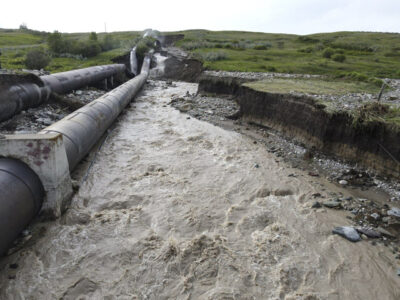Catastrophic flooding in Montana gifts water to Alberta
By Justin Sibbet - Lethbridge Herald Local Journalism Initiative Reporter on June 19, 2024.
 This photo released by the Bureau of Reclamation Missouri Basin Region, Montana Area Office, shows a breach in the St. Mary Canal siphon in Babb, Montana, Monday, June 17, 2024. The siphon is part of a system that carries water from a river on the Blackfeet Indian Reservation to another river that provides irrigation water to farmers and drinking water to 14,000 residents in northern Montana. No injuries or deaths have been reported since the century-old pipes broke open Monday. Officials do not know how long it will take to repair the damage. (Bureau of Reclamation Missouri Basin Region, Montana Area Office via AP)
Uncredited
This photo released by the Bureau of Reclamation Missouri Basin Region, Montana Area Office, shows a breach in the St. Mary Canal siphon in Babb, Montana, Monday, June 17, 2024. The siphon is part of a system that carries water from a river on the Blackfeet Indian Reservation to another river that provides irrigation water to farmers and drinking water to 14,000 residents in northern Montana. No injuries or deaths have been reported since the century-old pipes broke open Monday. Officials do not know how long it will take to repair the damage. (Bureau of Reclamation Missouri Basin Region, Montana Area Office via AP)
UncreditedLETHBRIDGE HERALDjsibbet@lethbridgeherald.com
A crack, a bang and a burst. Thousands of litres of water flowed freely from a pipe in the U.S. to the Alberta side of the border.
Following the major break at the St. Mary River Siphon near Babb, Montana, on Monday, water that would normally have been diverted to the American portion of the Milk River is now making its way into the St. Mary’s Reservoir in Alberta.
David Westwood, general manager for St. Mary’s Irrigation District, says this presents an opportunity for the reservoir to fill far beyond where estimates showed it would be able to this year.
“I think we could get closer to actually getting it filled this year, which I don’t think it was on that trajectory, but this might put it over the top. It really depends on how long this siphon takes to repair.”
Unfortunately, the flooding caused severe damage to a bar, hotel and roping arena in Montana. However, the Milk River Project says it could have been a lot worse.
“No one was hurt, but the damage is extensive,” said the organization in a post on Facebook.
Even with the challenges in Montana, the positives for silver lining for Alberta cannot be overstated, says Westwood.
“We get the benefit of all the water coming,” said Westwood.
This comes during a year in which drought conditions have left many on edge, with the Calgary watermain break causing even greater concerns across Alberta.
However, this burst is not the first time in recent years the Milk River has created challenges in Montana.
“This is similar to the event, not (in terms of scale), but same kind of cause and effect that happened back in 2020 when they had a drop structure failure.”
He says the repairs in 2020 took months, but this time around should be much faster.
“I think the siphon is going to be a quicker repair, but a similar result in that they have to stop water from being diverted down that path,” said Westwood.
He says it will take some time to fully understand the impact this will have on southern Alberta, but initial signs show it will at least help in the immediate future.
However, on the other side of the border the economic impact of the failure of the century-old pipes will depend on how long it takes crews to restore the flow of water to Montana producers, who are between 320 and 560 kilometers from the diversion. The Bureau of Reclamation will start working on those assessments, said Ryan Newman, the bureau’s Montana area manager.. Design work on a project to replace the pipes, which was underway before the pipes failed, is about 60% complete, he said.
Montana farmers with 120,000 acres (45,562 hectares) of land from Havre to Glasgow rely on the irrigation water, Newman said.
– with files from The Associated Press
19-18


